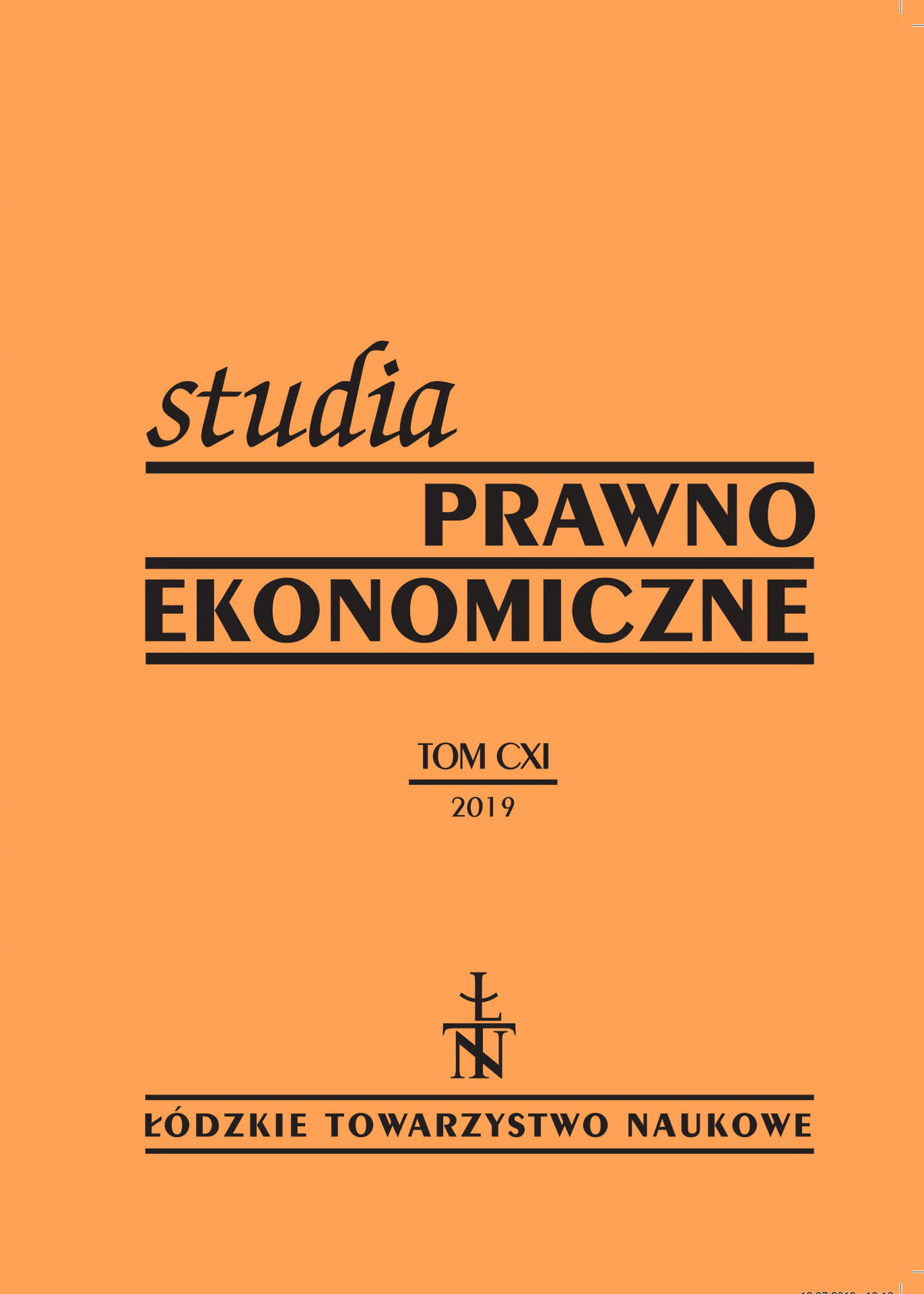Jak PPP może wpłynąć na rozwój regionalny Europy Środkowo-Wschodniej?
DOI:
https://doi.org/10.26485/SPE/2019/111/15Słowa kluczowe:
partnerstwo publiczno-prywatne; rozwój regionalny; państwa Europy Środkowo- Wschodniej; ramy instytucjonalne; potencjalna atrakcyjność inwestycyjna; jednostki samorządu terytorialnegoAbstrakt
Głównym celem niniejszego artykułu jest zaprezentowanie związku pomiędzy partnerstwem publiczno- prywatnym (PPP) a rozwojem regionalnym Europy Środkowo-Wschodniej w kontekście potencjalnej atrakcyjności inwestycyjnej regionów Europy Środkowo-Wschodniej. Na podstawie badań desk research, studium przypadku n = 90 projektów PPP i przeglądu literatury przedmiotu zbadano wpływ projektów PPP na rozwój regionalny Europy Środkowo-Wschodniej w kontekście atrakcyjności inwestycyjnej tych regionów, które realizują projekty PPP. Ponadto dokonano przeglądu kluczowych wyzwań, jakie stoją przed państwami Europy Środkowo-Wschodniej, a są związane m.in. z niewystarczającym poziomem rozwoju infrastruktury, którą cechuje wysoki stopień zużycia czy wysoki poziom długu publicznego brutto, w szczególności na poziomie jednostek samorządu terytorialnego (JST). Artykuł przedstawia również syntetyczną charakterystykę ram instytucjonalnych, państw Europy Środkowej i Wschodniej, niezbędnych do wspierania rozwoju PPP oraz przedstawia propozycje koniecznych zmian regulacji w zakresie PPP, aby przyspieszyć rozwój regionalny Europy Środkowo-Wschodniej w kontekście atrakcyjności inwestycyjnej. Ponadto JST w Polsce nie wykorzystują efektu synergii (dla wzrostu rozwoju regionalnego) z dostosowania realizowanych projektów PPP do regionalnych strategii rozwoju czy innowacji.
Liczba pobrań
Bibliografia
Directive 2014/23/EU of the European Parliament and of the Council of 26 February 2014 on the awarding of concession contracts (Official Journal of the European Union, L 94/1).
Directive 2014/24/EU of the European Parliament and of the Council of 26 February 2014 on public procurement and repealing Directive 2004/18/EC (Official Journal of the European Union, L94/65).
Regulation (EU) No. 1303/2013 of the European Parliament and of the Council of 17 December 2013 laying down common provisions on the European Regional Development Fund, the European Social Fund, the Cohesion Fund, the European Agricultural Fund for Rural Devel¬opment and the European Maritime and Fisheries Fund and laying down general provisions on the European Regional Development Fund, the European Social Fund, the Cohesion Fund and the European Maritime and Fisheries Fund and repealing Council Regulation (EC) No. 1083/2006.
Ustawa z dnia 5 lipca 20018 r. o zmianie ustawy o partnerstwie publiczno-prywatnym oraz niektórych innych ustaw (Dz.U. z 2018 r., poz. 1693) [Act of the 5th of July 2018 amending the act on public-private partnership and certain other acts (Journal of Laws, of 2018, item 1693)].
Acemoglu Daron, Robinson James, Why Nations Fail: The Origins of Power, Prosperity, and Poverty, Crown Publishers, New York 2012.
Annoni Paola, Dijkstra Lewis, Gargano Nadia, The EU Regional Competitiveness Index 2016, Working Papers WP 02/2017, European Commission 2017; http://ec.europa.eu/regional_policy/ sources/docgener/work/201701_regional_competitiveness2016.pdf; last visited 14.07.2018.
Dudkin Gerti, Välila Timo, Transaction costs in Public-Private Partnerships: A First Look at the Evidence, Competition and Regulation in Network Industries 2006/1/2, pp. 307–330.
The Economist Intelligence Unit (EIU), Evaluating the environment for public-private partnerships in Eastern Europe and the Commonwealth of Independent States The 2012 EECIS Infrascope, EIU 2012; https://infrascope.eiu.com/wp-content/uploads/2017/02/Eu-rope_Infrascope_Report_2012_English.pdf; last visited 10.06.2018.
European Commission, Regional aid; https://eur-lex.europa.eu/legal-content/EN/TXT/ PDF/?uri=CELEX:52016XC0625(01); last visited 28.06.2018.
European Court of Auditors (ECoA), Public-Private Partnership in the EU: Widespread shortcomings and limited benefits, ECoA 2018/09, https://www.eca.europa.eu/Lists/ ECADocuments/SR18_09/SR_PPP_EN.pdf; last visited 24.07.2018.
European Investment Bank (EIB), Market Update Review of the European PPP Market in 2016, EIB 2017; ; http://www.eib.org/epec/resources/publications/epec_market_update_2016_enlast visited 15.06.2018.
European Investment Bank (EIB), Market Update Review of the European PPP Market in 2017, EIB 2018; ; http://www.eib.org/attachments/epec/epec_market_update_2017_en.pdflast visited 15.06.2018.
Ferguson Niall, The Great Degeneration. How Institutions Decay and Economies Die, Penguin, 2014.
Godlewska Małgorzata, Partnerstwo publiczno-prywatne kluczem do stabilnego wzrostu, przy¬kład Malezji, Kwartalnik Nauk o Przedsiębiorstwie 2014/3, pp. 99–104.
Godlewska Małgorzata, Wpływ instytucji formalnych na rozwój partnerstwa publiczno-prywat¬nego – ekonomiczna analiza prawa, Współczesna Gospodarka 2018/9/2, pp. 57–74.
Godlewska-Majkowska Hanna (ed.), Atrakcyjność inwestycyjna a przedsiębiorczość regional¬na w Polsce, OW SGH, Warszawa 2011.
Godlewska-Majkowska Hanna (ed.), Atrakcyjność inwestycyjna regionów Polski na tle Unii Europejskiej, OW SGH, Warszawa 2013.
Godlewska-Majkowska Hanna, Czarnecki Mariusz, Godlewska Małgorzata, Bartoszczuk Paweł, Changes in Central and Eastern Europe from the Investor’s Perspective, in: Hanna Godlewska-Majkowska, Piotr Wachowiak, Mariusz Strojny, Bartosz Majewski, Wyzwania ekonomiczne dla Europy Środkowo-Wschodniej, OW SGH, Warszawa 2018, pp. 175–212.
GUS, Statystyczne Vademecum Samorządowca 2017; http://stat.gov.pl/statystyka-regionalna/sta¬tystyczne-vademecum-samorzadowca/; last visited 12.07.2018.
Hampton Gerard, Baldwin Andrew N., Holt Gary, Project delays and cost: stakeholder perceptions of traditional v. PPP procurement, Journal of Financial Management of Property and Construction 2012/17/1, pp. 73–91.
International Monetary Fund (IMF), Central, Eastern, and Southeastern Europe: Mind the Credit Gap, Regional Economic Issues 2015; http://www.imf.org/external/pubs/ft/reo/2015/ eur/eng/pdf/REI0515.pdf; last visited 10.07.2018.
Jachowicz Agnieszka, Partnerstwo publiczno-prywatne narzędziem efektywnej realizacji zadań publicznych, Difin, Warszawa 2015.
Laukkanen Mauri, Niittykangas Hannu, Local developers as virtual entrepreneurs – do diffi¬cult surroundings need initiating interventions?, Entrepreneurship and Regional Develop¬ment 2003/15(4), pp. 309–331.
Li Bing, Akintoye Akintola, Edwards Peter J., Hardcastle Cliff, Perceptions of positive and negative factors influencing the attractiveness of PPP/PFI procurement for construction projects in the UK: findings from a questionnaire survey, Engineering, Construction and Architectural Management 2005/12/2, pp. 125–148.
Ministry of Investment and Economic Development, PPP projects database; https://www.ppp. gov.pl/baza/Strony/baza_projektow_ppp.aspx/; last visited 10.07.2018.
National Audit Office (NAO), The performance and management of hospital PFI contracts, HC 68, Session 2010–2011, NAO 2010, https://www.nao.org.uk/wp-content/uploads/2010/06/101168. pdf, last visited 4.07.2018.
Panasiuk Andrzej, System zamówień publicznych. Zarys wykładu. Zamówienia klasyczne. Part¬nerstwo publiczno-prywatne, Public Procurement Legal Publisher, Warszawa 2013.
Pike Any, Rodriguez-Pose Andres, Tomaney John, Local and regional development in the Global North and South, Progress in Development Studies 2014/14/1, pp. 21–30.
Posner Paul, Ryu Shin K., Tkachenko Ann, Public-Private Partnership: The Relevance of Budgeting, OECD Journal on Budgeting 2009/1, pp. 1–26.
PwC, Building New Europe’s Infrastructure. PPP in Central and Eastern Europe, PwC 2013; ; http://pwc.blogs.com/files/building-new-europe39s-infrastructure---full-publication.pdflast visited 6.06.2018.
Regional Gross Public Debts; http://www.portalsamorzadowy.pl/prawo-i-finanse/mapa-zadluzenia-i-dochodow-wojewodztw-w-polsce,93986.html; last visited 12.07.2018.
Renda Andrea, Schrefler Lorna, Public-Private Partnerships. Models and Trends in the European Union, European Parliament, IP/A/IMCO/SC/2005-161, 2006; http://www. eurosfaire.prd.fr/7pc/doc/1265964211_ppp_briefing_note_en.pdf; last visited 15.07.2018.
Rodriguez-Pose Andres, Do Institutions Matter for Regional Development?, Regional Studies 2013/47/7, pp. 1034–1047.
Sejm, Ustaw z dnia 5 lipca 20018 r. o zmianie ustawy o partnerstwie publiczno-prywatnym oraz niektórych innych ustaw, Druk 2333; http://orka.sejm.gov.pl/opinie8.nsf/nazwa/2333_u/$fi¬le/2333_u.pdf; last visited 25.07.2018.
Soliño Antonio S., de Santos Pilar G., Transaction Costs in Transport Public-Private Partnerships: Comparing Procurement Procedures, Transport Reviews 2010/30/3, pp. 389–406.
Stiglitz Joseph E., Inequality and Economic Growth, Political Quarterly 2016/86/S1, pp. 134–155.
Torres Lourdes, Pina Vicente, Public-private partnership and private finance initiatives in the EU and Spanish local governments, The European Accounting Review 2001/10/3, pp. 601–619.
UMWD, Strategia Rozwoju Województwa Dolnośląskiego 2020, UMWD 2011; http://www. umwd.dolnyslask.pl/fileadmin/user_upload/Rozwoj_regionalny/SRWD/SRWD_2020-final. pdf; last visited 30.06.2018.
Wojewnik-Filipkowska Anna, Trojanowski Dariusz, Principles of public-private partnership financing – Polish experience, Journal of Property Investment & Finance 2013/31/4, pp. 329–344.
The World Bank (WB), The Growth Report: Strategies for Sustained Growth and Inclusive Development, WB, Washington 2008.
The World Bank (WB), Worldwide Governance Indicators 2016, WB 2018; http://info. worldbank.org/governance/wgi/#home; last visited 11.07.2018.



